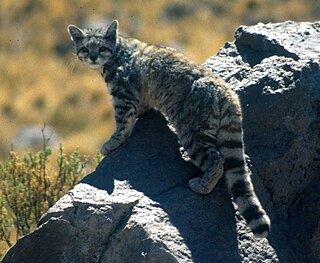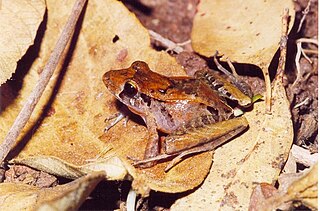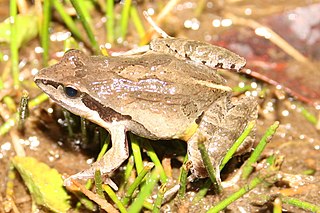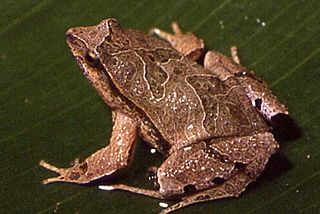
The Andean mountain cat is a small wild cat native to the high Andes that has been listed as Endangered on the IUCN Red List because fewer than 1,500 individuals are thought to exist in the wild. It is traditionally considered a sacred animal by indigenous Aymara and Quechua people.

Physalaemus is a large genus of leptodactylid frogs. These frogs, sometimes known as dwarf frogs or foam frogs, are found in South America. It is very similar to Leptodactylus, a close relative, and indeed the recently described Leptodactylus lauramiriamae is in some aspects intermediate between them.

The banded palm civet, also called the banded civet, is a viverrid native to Indomalaya. They primarily inhabit lowland conifer habitat, which is under threat from encroaching human activity. It is estimated the population of the banded palm civet has decreased by around 30% in just three generations. Banded palm civets are usually approximately the size of a domestic cat; their fur is pale but with dark bands on the back. They are believed to be closely related to Hose's palm civets, which are similar in appearance and distribution.

Dendrophryniscus berthalutzae is a species of toad in the family Bufonidae. It is endemic to southeastern Brazil where it is found in the coastal plain of Santa Catarina and Paraná states.

Bokermannohyla izecksohni, also known as Izecksohn's treefrog, is a species of frog in the family Hylidae. It is endemic to São Paulo state, Brazil. It was already considered possibly extinct in 2004, but three living frogs were discovered in 2005–2006. It is a medium-sized treefrog, measuring about 45 mm (1.8 in) in snout–vent length.

Xenohyla eugenioi is a species of tree frog in the Hylidae family native to northeastern Brazil in ecotones between the Atlantic Forest and caatingas. It has been found in the Brazilian states of Bahia and Sergipe, approximately 1,000 km away from the other species in its genus, Xenohyla truncata. Like its relative, this frog spends the day hiding in bromeliads, emerging at night to hunt and forage. This frog has been observed between 128 and 960 meters above sea level.
Cycloramphus izecksohni is a species of frog in the family Cycloramphidae. It is endemic to southern Brazil and occurs in the Serra do Mar in the states of Santa Catarina, Paraná, and São Paulo. Prior to its description in 1983, it was confused with Cycloramphus duseni. Common name Izecksohn's button frog has been coined for this species.

Ischnocnema izecksohni is a species of frogs in the family Brachycephalidae. It is endemic to the state of Minas Gerais, Brazil, and known from the Espinhaço and Mantiqueira Mountains. Common name Izecksohn's robber frog has been coined for this species.
Phantasmarana lutzae is a species of frog in the family Hylodidae. It is endemic to Brazil and only known from its type locality in the Itatiaia National Park, Rio de Janeiro state. It is named in honor of Bertha Lutz, a Brazilian zoologist and feminist.
Physalaemus aguirrei is a species of frog in the family Leptodactylidae. It is endemic to eastern Brazil and occurs in the southern Bahia, northern Espírito Santo and northeastern Minas Gerais. The specific name aguirrei honours Alvaro Coutinho Aguirre, a Brazilian zoologist. However, common name Linhares dwarf frog has been proposed for it.

Physalaemus barrioi is a species of frog in the family Leptodactylidae. It is endemic to Serra do Bocaina in São Paulo state, Brazil. The specific name barrioi honors Avelino Barrio, a Spanish botanist and zoologist who lived in Argentina. However, the common name Bocaina dwarf frog has been proposed for it.

Engystomops coloradorum, also known as Colorado dwarf frog, is a species of frogs in the family Leptodactylidae. It is endemic to the Pacific lowlands and foothills of the Andes in the Pichincha and Santo Domingo de los Tsáchilas Provinces, Ecuador.
Physalaemus deimaticus is a species of frog in the family Leptodactylidae. It is endemic to Brazil and only known from its type locality in Jaboticatubas, Serra do Cipó, Minas Gerais. The specific name deimaticus is derived from Greek deimos fror "fear" and refers to the defensive display of this frog, probably aimed at scaring predators. Common names Jaboticatubas dwarf frog and frightening foam froglet have been coined for it.

Physalaemus maculiventris is a species of frog in the family Leptodactylidae. It is endemic to Southeast and South Brazil and is known primarily from the Serra do Mar in Espírito Santo, Rio de Janeiro, São Paulo state, Paraná, and Santa Catarina states. Common name Mantagnes dwarf frog has been proposed for it.
Engystomops pustulatus is a species of frog in the family Leptodactylidae. It is known with certainty from western Ecuador, whereas the status of Peruvian records is ambiguous as they may refer to an undescribed species or possibly Engystomops puyango. Nevertheless, given that E. pustulatus is now known from Huaquillas in southern Ecuador, near the Peruvian border, it is likely to be found in Peru too.
Zachaenus carvalhoi is a species of frog in the family Cycloramphidae. It is endemic to southeastern Brazil and is known from the southern Espírito Santo and adjacent Minas Gerais.

Zachaenus parvulus is a species of frog in the family Cycloramphidae. It is endemic to southeastern Brazil and is known from the eastern São Paulo, Rio de Janeiro, and Espírito Santo states.

The rufous-headed robin is a species of passerine bird in the family Muscicapidae. It is found in central China. Its natural habitats are temperate forests and temperate shrubland. This poorly known species is thought to be threatened by habitat loss.

The Brazilian gold frog, also known as Izecksohn's toad or flea-frog, is a very small species of frogs in the family Brachycephalidae. It is endemic to southeastern Brazil and is known from the central part of the state of Rio de Janeiro and from Serra das Torres in extreme southern Espírito Santo.













